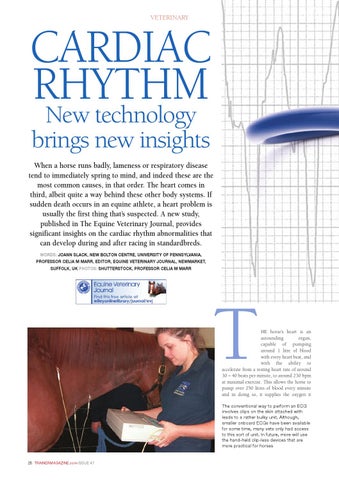VETERINARY
CARDIAC RHYTHM New technology brings new insights
When a horse runs badly, lameness or respiratory disease tend to immediately spring to mind, and indeed these are the most common causes, in that order. The heart comes in third, albeit quite a way behind these other body systems. If sudden death occurs in an equine athlete, a heart problem is usually the first thing that’s suspected. A new study, published in The Equine Veterinary Journal, provides significant insights on the cardiac rhythm abnormalities that can develop during and after racing in standardbreds. WORDS: JOAnn SlAck, neW BOltOn centRe, UniveRSity Of PennSylvAniA, PROfeSSOR celiA M MARR, eDitOR, eqUine veteRinARy JOURnAl, neWMARket, SUffOlk, Uk PHOtOS: SHUtteRStOck, PROfeSSOR celiA M MARR
T
HE horse’s heart is an astounding organ, capable of pumping around 1 litre of blood with every heart beat, and with the ability to accelerate from a resting heart rate of around 30 – 40 beats per minute, to around 230 bpm at maximal exercise. This allows the horse to pump over 250 litres of blood every minute and in doing so, it supplies the oxygen it The conventional way to perform an ECG involves clips on the skin attached with leads to a rather bulky unit. Although, smaller onboard ECGs have been available for some time, many vets only had access to this sort of unit. In future, more will use the hand-held clip-less devices that are more practical for horses
26 TRAINERMAGAZINE.com ISSUE 47
